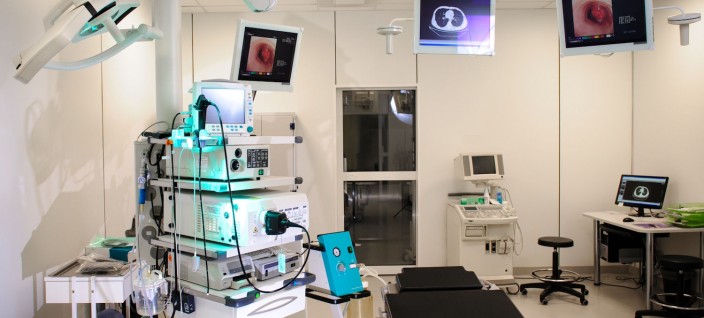Electromagnetic Navigation Bronchoscopy – pro
ENB (Electromagnetic Navigation Bronchoscopy) or EMN bronchoscopy is a type of bronchoscopy that uses electromagnetic guidance to project catheters into and through bronchial passages. Using a virtual, three-dimensional (3D) bronchial map from a recent CT scan and disposable catheters, it makes it possible to navigate to a desired location within the lung and to look at it or biopsy it, stage lymphatic nodes or to insert markers to guide future radioatherapy. FDA cleared it in 2004 through the 510(k) process. One prospective study concluded that there is a “yield/procedure [rate at] 74% and 100% for peripheral lesions and lymph nodes, respectively.” A diagnosis was obtained in 80.4% of bronchoscopic procedures. The second study found an overall 62.5% diagnostic. There are also a number of other series and non-randomized studies. The only randomized study was by Eberhardt et al (2007c) that compared the diagnostic yield of electromagnetic navigation bronchoscopy, endobronchial ultrasound and a combined procedure in 120 patients with peripheral lung lesions or solitary lung nodules on CT scans. Eelectromagnetic navigation bronchoscopy had a lower diagnostic yield (59 %) than endobronchial ultrasound (69 %). However, the combined procedure had a higher diagnostic yield (88 %) than either procedure alone. There was significantly diminished diagnosic yield (29 %) in the lower lobes with electromagnetic navigation bronchoscopy.
The British Thoracic Society guidelines for advanced diagnostic and therapeutic flexible bronchoscopy in adults (Du Rand et al, 2011) said that electromagnetic bronchoscopy may be considered for the biopsy of peripheral lesions or to guide trans-bronchial needle aspiration for sampling mediastinal lymph nodes (grade D). A grade “D” recommendation is based on evidence level 3 or level 4, or extrapolated evidence from studies rated as 2+ (level 3 refers to non-analytic studies, e.g., case reports, case series; level 4 refers to expert opinion; and level 2+ refers to well-conducted case-control or cohort studies with a low-risk of confounding, bias or chance, and a moderate probability that the relationship is causal). It is a fairly low level of confidence recommendation and not a USA guideline.
D.Makris et al, Electromagnetic navigation diagnostic bronchoscopy for small peripheral lung lesions ERJ June 1, 2007 vol. 29 no. 6 1187-1192
Andrew R. Haas Anil Vachani and Daniel H. Sterman Advances in Diagnostic Bronchoscopy Am. J. Respir. Crit. Care Med. 2010 182:589-597
Eberhardt R, Anantham D, Ernst A, et al. Multimodality bronchoscopic diagnosis of peripheral lung lesions. Am J Respir Crit Care Med. 2007c;176:36-41.
Daryl Phillip Pearlstein et al, Electromagnetic Navigation Bronchoscopy Performed by Thoracic Surgeons: One Center’s Early Success Ann. Thorac. Surg. 2012 93:944-950
Du Rand IA, Barber PV, Goldring J, et al; BTS Interventional Bronchoscopy Guideline Group. British Thoracic Society guideline for advanced diagnostic and therapeutic flexible bronchoscopy in adults. Thorax. 2011;66(3)::iii1-iii21. Available at: http://www.brit-thoracic.org.uk/Portals/0/Guidelines/BronchoscopyGuidelines/BTS%20Advanced%20Bronchoscopy%20guideline%20November%202011.pdf.
For Lay version see here

